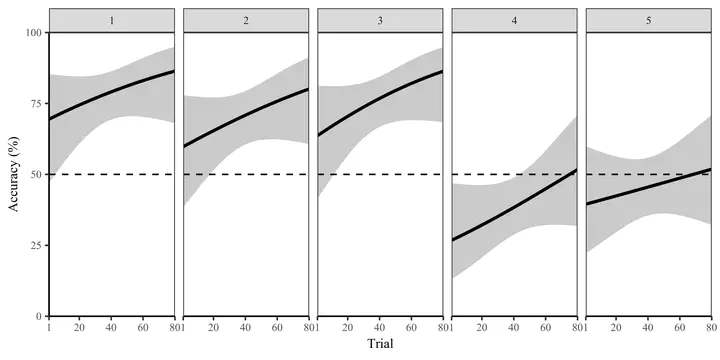Visual discrimination of geometric and complex 2D shapes in goldfish (Carassius auratus)
 The performance accuracy of the fish in Experiment 2 shown for each stimulus pair 1–5. Because the interaction between trial number and stimulus pair was not significant, none of the slopes were significantly different from each other. Model estimated accuracies are shown along with 95% Tukey-adjusted confidence intervals. Pair 1 = area matched, pair 2 = length matched, pair 3 = length and width matched, pairs 4 and 5 = diameter and area matched.
The performance accuracy of the fish in Experiment 2 shown for each stimulus pair 1–5. Because the interaction between trial number and stimulus pair was not significant, none of the slopes were significantly different from each other. Model estimated accuracies are shown along with 95% Tukey-adjusted confidence intervals. Pair 1 = area matched, pair 2 = length matched, pair 3 = length and width matched, pairs 4 and 5 = diameter and area matched.Abstract
Visual object recognition allows fish to locate prey, avoid predators, recognize individuals, choose mates, and navigate. Previous studies have examined shape discrimination in goldfish, but without controlling multiple dimensions of the stimuli to closely examine which features are salient for fish. The goal of this study was to explore features that goldfish (Carassius auratus) may use to discriminate between 2D geometric and complex shapes (e.g., length, width, area, diameter, symmetry). We assessed shape perception in fish using a two-alternative forced choice task. Five stimulus pairs were presented to goldfish: (1) a solid circle and rectangle matched for area; (2) a solid circle and rectangle matched for length; (3) a solid circle and square matched for length and width; (4) an unfilled circle and four-blade fan matched for diameter, area, and symmetry; and (5) two concentric unfilled circles and six-blade fan matched for diameter, area, and symmetry. Fish were tested using the ‘correction method’ in Experiment 1 and the ‘non-correction method’ in Experiment 2. Goldfish visually discriminated between the geometric shapes (stimulus pairs 1-3), but failed to discriminate between complex shapes (stimulus pair 5). Only the fish in Experiment 1 learned to discriminate between the complex shapes in stimulus pair 4. This study provided preliminary evidence for shape discrimination in goldfish when stimulus features are controlled. However, further work is needed to determine whether goldfish use a single feature that changes from stimulus pair to stimulus pair, a combination of features, or holistic processing to discriminate among shape stimuli.